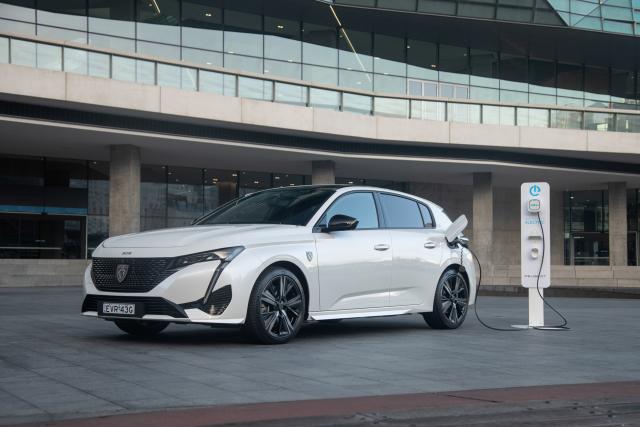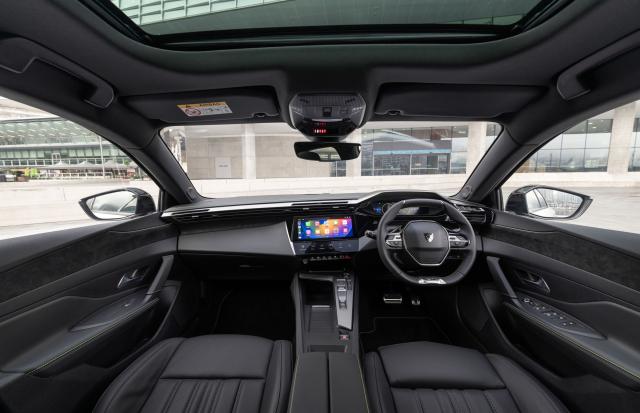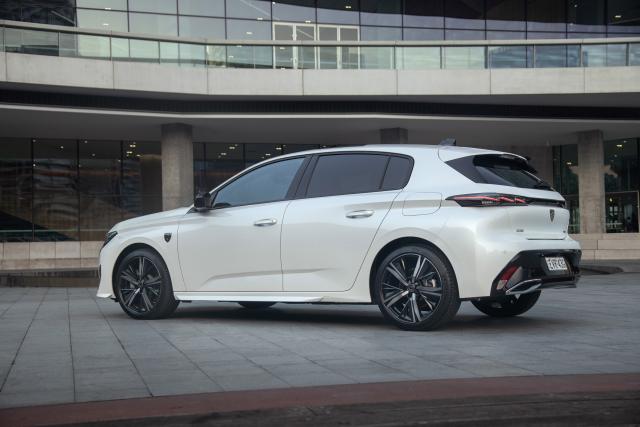Peugeot’s GT Sport Plug-In Hybrid (PHEV) hatchback has become the fourth model to join the French carmaker’s 308 compact range. It joins the GT hatch, GT Premium hatch and GT Premium wagon petrol variants.
First sold here in 2008, the 308 has never seriously challenged comparable models from Japan or South Korea for sales, but those loyal to the French brand have always loved it for its style, comfort and handling.
The new 308 PHEV is Peugeot’s third plug-in petrol-electric hybrid, joining the 3008 GT Sport SUV and 508 Fastback GT with two more set to arrive later this year – the 2008 small SUV and 508 Sportwagon.
Also coming later in 2023 will be Peugeot’s first fully electric vehicles, the e-Partner small van and e-2008 compact SUV.
STYLING
We love the looks of the latest 308 starting at the front where a large, intricate grille flanked by LED Matrix headlights and claw-shaped daytime running lights.
The 308 is the first Peugeot model to feature the latest iteration of the iconic Peugeot lion badge sitting in the centre of the grille as well as on the front side panels, boot lid and in the centre of the eye-catching black alloy 18-inch wheels.
The rear has also been given a serious makeover with tri-segment tail lights on either side and the lion-claw in the centre of each.
The battery charging socket is at the rear of the passenger side.
POWERTRAIN
308 GT Sport PHEV combines a 1.6-litre 132 kW/250Nm 1.6-litre, four-cylinder petrol engine with an 81kW electric motor for combined power and torque outputs of 165kW and 360Nm.
It is integrated with an e-EAT8 transmission, which for this application has the traditional torque converter replaced with a wet, multi-disc clutch.
As with the other 308 variants the GT Sport PHEV is front-wheel-drive.
The 12.4kWh Li-ion battery with 100kW of battery power and 3.7 kW onboard charger provides a WLTP test range of 60km in electric-only driving. Fuel tank capacity is 40 litres.
Three driving modes are available: Electric, Hybrid and Sport.
The 308 GT Sport PHEV comes as standard with a mode two charging cable, supplied with the vehicle at time of delivery. The on-board charger unit restricts the accepted charger to a capacity of 3.7kW.
Using a domestic power socket with a 2.3kW single-phase 10A charger, the battery will be charged in around 5.5 hours. With a home charging station such as a Wallbox this will reduce to about 3.5 hours.
SAFETY
There’s a comprehensive list of safety features across the entire 308 range. Highlights include autonomous emergency braking with pedestrian and cyclist detection, active cruise control with Stop & Go function, forward collision warning, long-range blind spot detection, rear cross traffic alert, lane departure warning with unmarked road edge detection, advanced driver inattention alert, speed limiter function, tyre pressure warning and two Isofix child seat mounts.
GT Premium and GT Sport PHEV add active lane positioning assist while the PHEV gets Acoustic Vehicle Alerting System (AVAS) which generates sound when the car is travelling at low speed to alert pedestrians.
When tested by ANCAP in November 2022 the absence of a front centre airbag, which is a relatively new feature, led to 308 getting a four-star rating.
INFOTAINMENT
The infotainment system features satellite navigation, wireless smartphone charging, wireless Apple CarPlay and Android Auto, two front and two rear USB sockets, wireless phone mirroring, voice recognition, with Peugeot iConnect and the myPeugeot app.
Like so many recent new vehicles, far too many features, including climate control, need to be accessed through the touchscreen with the driver’s attention inevitably being taken away from the road ahead.
There is a power and volume knob for the audio system and there are short-cuts through a smaller horizontal screen called i-Toggles – but drivers will need to spend a lot of time learning how to access the various features.
DRIVING
Peugeos have always been among our favourite driving cars and the instant torque from the 308 PHEV further enhances that enjoyment. It’s great fun to drive both around town and in the hilly terrain segment of our rural drive route while it cruises effortlessly on the motorway.
While the PHEV’s battery adds around 230kg to overall weight over its petrol-only siblings it can still get from zero to 100km/h more than two seconds faster at 7.5 seconds.
The ride is relatively firm but not uncomfortable while steering is light and direct.
Using the outdated NEDC test procedure Peugeot lists fuel consumption at 1.3L/100km for the 308 PHEV. The result is based on starting with the battery fully charged, travelling the claimed maximum distance in EV mode (60km) before automatically switching to hybrid mode for the remainder of the 100km trip.
The anomaly in the system is that, after travelling 100km the only way to repeat such low fuel usage would be to stop and fully recharge the battery before continuing.
During three separate tests the best battery-only distance we could achieve was 52km.
With the battery fully-charged we covered 100km using 3.4L/100km. Although that’s nearly double the listed figure it’s still pretty good. However, once the battery is flat, and running in normal hybrid mode including battery regeneration, we averaged a less-impressive 5.6L/100km.
SUMMING UP
As enjoyable as the Peugeot 308 PHEV is to drive the biggest problem is its price. At $64,990 plus on-roads it’s between $16,000 and $23,000 dearer than its petrol-only siblings.
Do the sums and it’s very hard to financially justify spending that sort of money, but no doubt dyed-in-the wool environmentally-focused Peugeot enthusiasts will be willing to do so.









